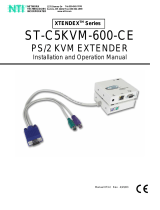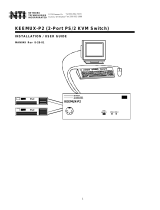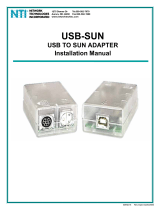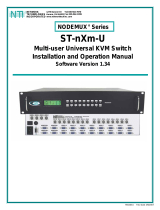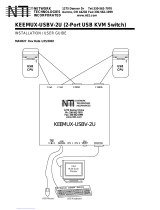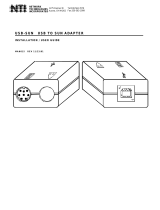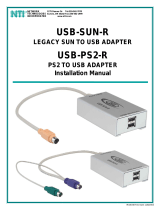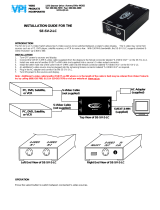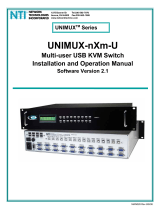Page is loading ...

KEEMUX-P2 (2-Port PS/2 KVM Switch)
INSTALLATION / USER GUIDE
MAN049 Rev Date 4/8/2004
KEEMUX
®
Series

WARRANTY INFORMATION
The warranty period on this product (parts and labor) is two (2) years from the date of purchase. Please contact Network
Technologies Inc at (800) 742-8324 (800-RGB-TECH) in the US and Canada or (330) 562-7070 (worldwide) or at our website at
http://www.networktechinc.com for information regarding repairs and/or returns. A return authorization number is required for all
repairs/returns.
COPYRIGHT
Copyright© 2004 by Network Technologies Inc. All rights reserved. No part of this publication may be reproduced, stored in a
retrieval system, or transmitted, in any form or by any means, electronic, mechanical, photocopying, recording, or otherwise,
without the prior written consent of Network Technologies Inc, 1275 Danner Drive, Aurora, OH 44202
CHANGES
The material in this guide is for information only and is subject to change without notice. Network Technologies Inc reserves the
right to make changes in the product design without reservation and without notification to its users.

1
TABLE OF CONTENTS
INTRODUCTION ...............................................................................................................................................................................1
MATERIALS......................................................................................................................................................................................1
FEATURES AND FUNCTIONS.........................................................................................................................................................2
INSTALLATION ................................................................................................................................................................................3
Units with audio support (optional)............................................................................................................................................4
Power-Up Sequence ....................................................................................................................................................................4
Power-Down Sequence ...............................................................................................................................................................4
USING THE NTI SWITCH ................................................................................................................................................................. 4
Front Panel Control .....................................................................................................................................................................4
Keyboard Control.........................................................................................................................................................................5
COMMAND Mode .....................................................................................................................................................................5
SCAN Mode ..............................................................................................................................................................................5
BROADCAST Mode..................................................................................................................................................................5
Keyboard Features ..................................................................................................................................................................6
AUDIO SUPPORT.............................................................................................................................................................................6
DUAL VIDEO SUPPORT .................................................................................................................................................................. 6
RS232 CONTROL .............................................................................................................................................................................6
TECHNICAL SPECIFICATIONS .......................................................................................................................................................8
REMOTE (RMT-2-ST) .......................................................................................................................................................................9
TROUBLESHOOTING ......................................................................................................................................................................9
INTRODUCTION
The KEEMUX-P2 switch allows one user to access two PS/2 CPUs with only one keyboard, monitor and mouse. Internal auto-
boot circuitry allows both CPUs to boot simultaneously and error-free without the need for a keyboard, monitor and mouse on
each CPU.
Available Options
• A KEEMUX-P2 can be ordered that supports a hard-wired remote control (RMT-2-ST) for increased user control flexibility.
Add "-RMT" to the part number. (i.e. KEEMUX-P2-RMT) The RMT-2-ST remote (ordered separately) comes standard with
a 6 foot cable but a cable of up to 100 feet can be ordered
(DKEXT-35/50/75/100).
• Audio support to enable user to connect stereo speakers to receive audio signals from connected CPUs- add "-AUD" to the
part number (i.e. KEEMUX-P2-AUD)
• RS232 support for alternative control using RS232 connection. Add "-RS" to the part number (i.e. KEEMUX-P2-RS)
• Dual Video option supports CPUs with two video outputs. Add "-DV" to the part number (i.e.KEEMUX-P2-DV)
See our catalog, visit our website at
http://www.nti1.com, or contact your NTI sales representative for more details.
MATERIALS
Materials Supplied with this kit:
• NTI KEEMUX-P2 PS/2 KVM Switch
Additional material supplied when model includes AUD, RS, or DV option:
• 120VAC or 240VAC at 50 or 60Hz-9VDC/0.5A AC Adapter
Materials Not Supplied, BUT REQUIRED:
A set of 2 cables for each CPU being connected to the switch must be used:
PS/2 CPU to switch
• VEXT-xx-MM
• (1) VVKINT-xx-MM for keyboard and mouse interface.
OR
(2) VKINT-xx-MM for keyboard or mouse interface

2
FEATURES AND FUNCTIONS
1. CPU Status LEDs- for visual indication of connection between the user and a specific CPU. Also used for
visual indication of switch mode status
2. CPU Select Switches- push to manually switch to a specific CPU
3. Remote- (optional) for connection of RMT-2-ST remote control
4. PC x VIDEO- 15HD female connectors- for attachment of video cables from CPUs
5. MONITOR - 15HD female connector- for connection of user monitor
6. PC x- 6 pin miniDIN female connectors- for connection of keyboard and mouse cables from CPUs
7. USER- 6 pin miniDIN female connectors- for connection of user's keyboard and mouse
8. PWR - for connection of optional power supply
9. AUD x- (optional) for connection of audio cables from audio sources
10. AUD OUT- (optional) for connection of audio cable to audio output devices (speakers)
11. RS232- (optional) for attaching RS232 interface cable from a CPU to control the functions of one or more
switches
12. DIP SWITCHES- (optional) for configuring RS232 communication and addressing functions
AUD OUT
AUD 2
PC 2 VIDEO
12
43
65
USER
12
43
65
12
43
65
PC 1 VIDEO MONITOR
PC 1 PC 2
PWR
12
43
65
12
43
65
12
43
65
MOUSE
KYBD
AUD 1
CPU 1 CPU 2
CPU
SELECT
Remote
NTI
R
Network Technologies Inc
KEEMUX
R
23
45
6
7
8
9
RS232
11
1
10
ON
OFF
1 2 3 4 5 6 7 8
12

3
INSTALLATION
1. Turn OFF power to all CPUs that will be connected to the NTI Switch before connecting or disconnecting any cables.
WARNING! Damage to the CPU may result if power is not turned OFF before connecting or disconnecting cables.
2. Connect PS/2 keyboard to “USER KEYBD” port on the rear panel of the switch. (See Fig. 1)
3. Connect PS/2 mouse to “USER MOUSE” port on the rear of the switch.
4. Connect monitor to “MONITOR” port on the rear of the switch.
5. Using (1) VVKINT-xx-MM or (2) VKINT-xx-MM or VKEXT-xx-MM cables (Fig. 2 & 3, required, not supplied), connect the
keyboard and mouse ports of a PS/2 CPU to “PC 1 KEYBD” and “PC 1 MOUSE” ports on the rear of the switch.
6. Using VEXT-xx-MM (Fig. 4, required, not supplied), connect the video port of a PS/2 CPU to “PC 1 VIDEO” port
on the rear of the switch.
7. Repeat steps 5 & 6 for connecting a second CPU to the remaining ports on the rear of the switch.
Male
6 pin miniDIN
PS/2
Male
6 pin miniDIN
PS/2
VKINT-6/10-MM
VKEXT-25/50-MM
Male
6 pin miniDIN
PS/2
Male
6 pin miniDIN
PS/2
VVKINT-3/6/10/15/25/50-MM
Male
15HD
VGA
Male
15HD
VGA
VEXT-3/6/10/15/25/35/50/75/100-MM
Fig. 4
Fig. 3
Fig. 2
Fig. 1
VGA
Multi-Scan
Monitor
PS/2 Keyboard
VEXT-xx-MM
VEXT-xx-MM
VKINT-xx-MM
VVKINT-xx-MM
VKINT-xx-MM
PS/2 Mouse
PC 2 VIDEO
12
43
65
USER
12
43
65
12
43
65
PC 1 VIDEO
MONITOR
PC 1 PC 2
PWR
12
43
65
12
43
65
12
43
65
MOUSE
KYBD
Rear View of KEEMUX-P2
P
S
2
C
P
U
P
S
2
C
P
U

4
Units with audio support (optional)
Connect the 3.5mm plug from speakers to the 3.5mm jack labeled "AUD OUT". Attach SA-xx-MM audio cables (purchased
separately) between the audio port on each CPU and the 3.5mm audio jacks marked "AUD 1" on the KEEMUX switch. Be sure
to connect the audio cables from each CPU to audio jacks of the same number as the keyboard, mouse, and video cable ports
connected to. ( See Fig. 5).
Power-Up Sequence
1. The KEEMUX-P2 is powered by the CPUs it is connected to (unless using a power supply with an option).
2. Turn ON power to monitor attached to the KEEMUX-P2.
3. Turn ON power to either or both CPU(s) attached to the KEEMUX-P2.
Power-Down Sequence
1. Turn OFF CPUs attached to the KEEMUX-P2.
2. Turn OFF power to monitor attached to the KEEMUX-P2.
USING THE NTI SWITCH
The switch can be operated by the front control panel or by keyboard control.
Front Panel Control
1. Pressing the touch switch on the front panel will toggle between CPU 1 and CPU 2 and connect the selected CPU to the
keyboard, monitor and mouse.
2. Holding down the "CPU SELECT" button for more than 2 seconds will cause the switch to cycle through 3 extended modes of
operation: SCAN, BROADCAST, and COMMAND (see below for Command, Scan and Broadcast Mode sections). Release
the button when the desired mode has been selected.
Fig. 5
Rear View of KEEMUX-P2-AUD
AUD OUT
AUD 2
Speakers
3.5mm Stereo
Plug
3.5mm Stereo
Jack
Audio Port
line
out
ONE WILL BE MARKED "line
out" ,"spkr", "headphones"
OR WITH THIS SYMBOL
3.5mm Stereo
Plug
3.5mm Stereo
Plug
SA-xx-MM
Rear View of
PS/2 CPU
PC 2 VIDEO
12
43
65
USER
12
43
65
12
43
65
PC 1 VIDEO
MONI TOR
PC 1 PC 2
PWR
12
43
65
12
43
65
12
43
65
MOUSE
KYBD
AUD 1
12
43
65
12
43
65
12
43
65
12
43
65
12
43
65
12
43
65

5
Keyboard Control
In order to control the switch with the keyboard, COMMAND Mode must be enabled. To enter/exit COMMAND Mode from the
keyboard:
Press
COMMAND Mode
When the COMMAND Mode is ON, all 3 status LEDs on the keyboard will illuminate to indicate that COMMAND Mode is enabled
and the following functions are available: (NOTE: The user must exit COMMAND Mode in order to type to a CPU.)
Function: Keystroke:
Increment Port
Decrement Port
Toggle “SCAN” Mode
ON and OFF
Toggle “BROADCAST”
Mode ON and OFF
Sets scan time-out
period for each port.
Selects a specific
port
Exit COMMAND Mode
SCAN Mode
SCAN Mode is indicated by a flashing CPU port LED. The switch scans to either port with a CPU powered-ON. That port remains
active for the configured dwell time (default time is 5 seconds) before switching to the other powered-ON CPU port. See
COMMAND MODE Section for configuring the scan dwell time.
NOTE: The keyboard and mouse must remain idle for the full SCAN dwell time before the switch selects the other port.
BROADCAST Mode
(USE WITH EXTREME CAUTION)
BROADCAST Mode is indicated when both CPU LEDs are illuminated. This mode allows the operator to send keystrokes to both
active CPUs simultaneously. However, BROADCAST Mode has some critical requirements:
1. BROADCAST Mode must be OFF when booting an attached CPU.
2. COMMAND Mode must be OFF for keystrokes to reach attached CPU(s) when in BROADCAST.
S
I
or
(move to next higher port)
`
+
Ctrl
~
(ACCENT
KEY)
`
T
-
-
(xxx from 002 to 255. ie. t 002
would set the time-out period
for 2 seconds)
-
(0-2)
x
(0-9)
x
(0-9)
x
D
or
(move to next lower port)
CHORDED SEQUENCE- PRESS CONSECUTIVELY
AND KEEP KEYS PRESSED UNTIL ALL ARE PRESSED.
+
-
PRESS CONSECUTIVELY
or
PRESS EITHER KEY
KEY SYMBOLS LEGEND:
Esc
`
+
Ctrl
~
(ACCENT
KEY)
or
CPU 1
CPU 2
Two illuminated CPU LEDs
means that the switch is
in BROADCAST Mode.
CPU 1
CPU 2
A flashing CPU LED means
that CPU is being scanned
and is active.
B
P
-
-
(P0x would be P01 or P02)
x
0

6
Keyboard Features
The keyboard configuration of each CPU is saved in the NTI Switch. For example, if the CPU attached to Port 2 had CAPS LOCK
and NUM LOCK selected the last time that CPU was accessed, then they will automatically be set when that CPU is accessed
again.
AUDIO SUPPORT
(Optional)
Audio support provides the following additional features:
• Audio signals from the same CPU that keyboard, mouse, and video signals are from can be received by the user.
• Audio inputs accept any standard line level audio (1Vrms or 2.5Vp-p).
• Audio outputs are capable of driving an 8 Ohm speaker load with 200mW of continuous RMS power.
Audio signals are switched along with the keyboard, mouse and video signals using the buttons on the KEEMUX switch.
DUAL VIDEO SUPPORT
(Optional)
Dual Video support enables CPUs with two video outputs to be connected to the KEEMUX switch and two user monitors to be
connected to view both sets of video signals. Both monitors must be of the type VGA multi-scan.
RS232 CONTROL
(Optional)
RS232 Connections and Configuration
Remote Connection
The RS232 Interface is designed to meet the RS232C standard and can be controlled from any host CPU or other controller with
an RS232 communications port. The pin-out for the DB-9 connector on the unit can be found on page 7. A straight through DB-9
cable (not null modem) will work for most CPUs.
Baud Rate
The baud rate of the host CPU can be changed by using the menus in the RMTEST program (see "RS232 Interface Test
Program" below). The desired baud rate of 9600, 2400, 1200, or 300 may be set. A data protocol of 8 data bits, no parity, and 1
stop bit is used for communications. The baud rate of the KEEMUX is configured using dipswitches (see page 7).
Unit Address
To allow multiple units to be controlled from a single host port, the RS232 control interface is designed to allow "daisy chaining" up
to 15 units. In order to connect multiple KEEMUX units together a Matrix-Y-1 cable must be used. (See Fig. 6). See Fig. 7 for
the pinout of the Matrix-Y-1 cable.
NTI
SWITCH
CPU
RS232
First Unit
NTI
SWITCH
RS232
NTI
SWITCH
RS232
Second Unit
Last Unit
RS232
Serial Port
Matrix-Y-1
Matrix-Y-1 Matrix-Y-1
Fig. 6

7
ON
OFF
1 2 3 4 5 6 7 8
Dipswitches
The dipswitches located next to the RS232 connection (Fig. 8) are used to configure the baud rate and
address of the KEEMUX. The default baud rate is 9600. The default address is 1. Use the charts
below to change the baud rate and address as needed.
DIP SWITCH
The unit powers up with a default
baud rate of 9600 and a fixed data
protocol of 8 data bits, no parity, and
1 stop bit. To change the baud rate,
unit address, and loop back (more on
the unit address and loop back later),
an 8-SPST DIP switch on the panel
near the DB-9 connectors can be
used. This table shows the DIP switch
functions and their default positions.
SWITCH FUNCTION
DEF-
AULT
1 loop back ON
2 baud rate 0 ON
3 baud rate 1 ON
4 baud rate 2 ON
5 unit address 0 ON
6 unit address 1 OFF
7 unit address 2 OFF
8 unit address 3 OFF
BAUD RATE
The baud rate can be
changed by powering
down the unit,
changing the DIP
switch, and then
powering back up.
This table shows how
to set the baud rate.
DIP SWITCH BAUD
RATE
4 3 2
OFF OFF OFF 300
OFF OFF ON 600
OFF ON OFF 1200
OFF ON ON 2400
ON OFF OFF 4800
ON OFF ON 9600
ON ON OFF 9600
ON ON ON 9600
DIP SWITCH UNIT ADDRESS
8 7 6 5
OFF OFF OFF OFF 0 (not valid)
OFF OFF OFF ON 1
OFF OFF ON OFF 2
OFF OFF ON ON 3
OFF ON OFF OFF 4
OFF ON OFF ON 5
OFF ON ON OFF 6
OFF ON ON ON 7
ON OFF OFF OFF 8
ON OFF OFF ON 9
ON OFF ON OFF 10
ON OFF ON ON 11
ON ON OFF OFF 12
ON ON OFF ON 13
ON ON ON OFF 14
ON ON ON ON 15
UNIT ADDRESS
To allow multiple units to be controlled from a single host
port, the remote interface is designed to allow "daisy
chaining" of up to 15 units. By setting the appropriate
DIP switches, each unit can be given a unique address
(1-15). Then the unit will only respond to commands on
the bus if its address is embedded in the command. The
"loop back" DIP switch should be ON for the last unit in
the chain, and OFF for all other units. If only one unit is
being controlled, DIP switch 1 should be left ON. This
table shows how to set the unit address.
(Unit #1)
(Source)
23
33
555
22
7
8
1
4
6
Jumper
Jumpers
Not connected to
source connector
(Unit #2)
9D Female9D Male 9D Male
Wiring Schematic of Matrix-Y-1 cable
Fig. 7
Fig. 8

8
RS232 Interface Test Program
RS232 communication is configured using the RMTEST program, located on the supplied floppy disk. This software allows a
user to test the functions of an NTI KEEMUX or Multi-user/Multi-platform switch RS232 interface. The RMTEST program
generates a main menu with the 3 selections described below:
MAIN OPTIONS
1. Matrix Options - send commands to the unit.
2. Setup Options - set COM port, baud rate, and unit address
3. Quit - quit the program
If Matrix Options is selected, the following menu, which has 7 options, is displayed:
MATRIX OPTIONS
1. Reset single unit - reset single matrix to power-up defaults (not applicable)
2. Reset all units - reset all daisy chained matrix units (not applicable)
3. Change single output - connect an input to one output
4. Change all outputs - connect an input to all outputs
5. Read single output - read which input is connected to an output
6. Read unit size - read how many inputs and outputs the unit has
7. Return to main menu - go back to the MAIN OPTIONS menu
The Setup Options main menu selection only needs to be executed if the switches baud rate or unit address have been changed
from the factory defaults ( 9600 baud, and unit address = 1). When this option is selected, the following menu, which has 4
options, is displayed:
SETUP OPTIONS
1. Set COM port (default = COM1) - set port to COM1-COM3
2. Set baud rate (default = 9600) - set baud rate (see interface manual for supported baud rates)
3. Set unit address (default = 01) - set the unit address (if multiple units are daisy-chained)
4. Return to main menu - Go back to the MAIN OPTIONS menu
For any selection that requires user input, the user is prompted. When commands are sent to the KEEMUX, the command string
and KEEMUX responses are echoed to the screen. All commands generated by the program are formatted according to the
information provided in the sections above. If any transmission problems are detected, an error message is displayed.
TECHNICAL SPECIFICATIONS
PS2 Keyboard or Mouse VGA Video
Pin # Signal PIN# Signal Pin # Signal
1 KYBD DATA 1 RED 9 NC
2 MOUSE DATA 2 GREEN 10 GND
3 GND 3 BLUE 11 ID0
4 +5 4 ID2 12 ID1
5 KYBD CLOCK 5 TST 13 HS
6 MOUSE CLOCK 6 RED GND 14 VS
7 GREEN GND 15 NC ID3
8 BLUE GND
Mating face of a 6 pin miniDIN female
PS/2 KEYBOARD AND MOUSE
Mating face of a 15HD male
VGA VIDEO
1 2 3 4 5
6 7 8 9 10
11 12 13 14 15
2
1
4 3
6
5

9
RS232 Port (DB-9 MALE)
PIN SIGNAL FUNCTION
1 - No connection
2 RXD Receive data
3 TXD Transmit data
4 DTR Data terminal ready
5 GND Signal ground
6 DSR Data set ready
7 RTS Request to send
8 CTS Clear to send
9 - No connection
REMOTE (RMT-2-ST)
5 DIN SIGNAL DESCRIPTION
1 LED1 TTL output, low = port 1 selected
2 LED2 TTL output, low = port 2 selected
3 SWT TTL of contact closure input (10K pullup)
4 GND Ground
5 PWR +5V for LEDs, limited to 20mA
Low= < .4 volts High=> 2.4 volts
Control: When pin 3 (SWT) is brought low for a minimum of 10 MS, and then returned high, the switch will select the other port
(toggle).
TROUBLESHOOTING
1. Verify all cables are securely connected and that installation procedure was carefully followed.
2. Verify that the power-up sequence was observed.
3. If a CPU seems to be locked up, press the "CPU SELECT" button a couple of times.
4. If the problem still persists, unplug the keyboard and mouse cables (not the CPU keyboard and mouse) from KEEMUX-P2
and reconnect them.
5. If the KEEMUX-P2 switch continues to have erratic or inconsistent operation, there may not be enough power coming from
the CPUs to operate it (common with some older CPUs). If this is the case, contact NTI and order an optional power supply
(PS0018).
If the suggestions above have been tried and the KEEMUX-P2 KVM switch is still not functioning properly, a solution to the
problem may be found on our website at http://www.networktechinc.com in the Frequently Ask Questions (FAQ) section, or,
please call us directly at (800) 742-8324 (800-RGB-TECH) or (330) 562-7070 and we'll be happy to assist in any way we can.
5
3
2
4
1
Mating face of a
5 DIN female
1
Mating Face
of DB-9 Male
23
4
5
6
7
89

10
SERIAL NO.:
DATE:
INSPECTED BY:
KEEMUX-P2
KEEMUX-P2-RMT
KEEMUX-P2-AUD
KEEMUX-P2-DV
Man049 Rev. 4/8/04
/


